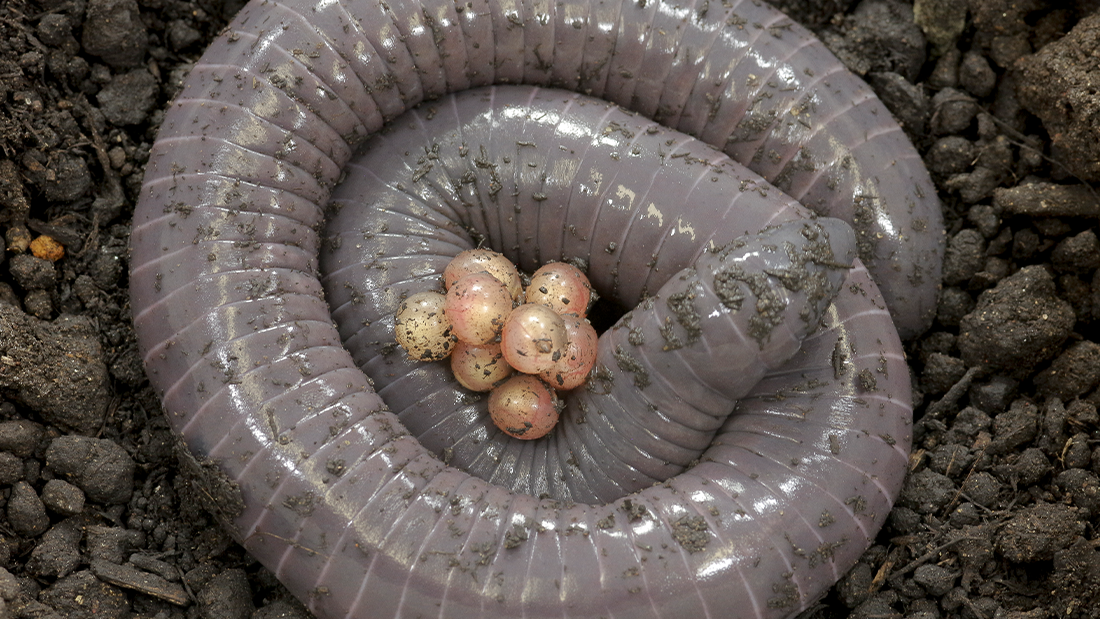Parental care in the animal kingdom comes in many forms. From those that lovingly protect their eggs, to families that stay together for their entire lives. While parental care and the providing of milk to offspring is typically seen as a mammalian trait, for the first time, it seems amphibians are getting in on the act as well.
While more well-known amphibians include frogs and toads, which belong to the order Anura, and the order Caudata, which contains salamanders, there is a third amphibian group that is less well studied: Gymnophiona, also known as the caecilians.
Caecilians are snake or worm-like amphibians that number around 222 species. They are entirely limbless and live mostly in tropical regions. Within these species are those that lay eggs, and species that give birth to live young. Both sets of mothers provide the offspring with nutrition after birth, in some species this is known as skin feeding, where the offspring actively consume the skin of the mother after hatching. While this sounds gross, it’s about to get much worse.

Siphonops annulatus with her eggs before hatching.
Image Courtsey of Carlos Jared
The researchers were studying the ringed caecilian (Siphonops annulatus), which is known to be an egg-laying or oviparous species. Siphonops annulatus is known to feed offspring through skin feeding but the researchers also saw the young consuming a substance from the mother’s vent. By closely following the progress of the hatchlings in a captivity setting, the team saw that the young always had stomachs full of fluid, suggesting that the substance they were consuming from the vent had important nutritional value.
The team studied 16 adult females with offspring to better understand the process. The animals were all collected during fieldwork in Ilhéus, Bahia state in Brazil. Each mother had between four and 13 hatchlings. For the largest amount of time over the study period, the hatchlings and their mothers remained curled up together. Caecilan mothers do not feed while caring for their hatchlings and their skin changes color to reflect the production of a lipid-based product for the skin feeding.
Additionally, the team observed the young being very interested in the mother’s vent and the end of her body, often touching it or even nibbling at it. The offspring also produced a high-pitched sound when interacting with the vent, which caused the mother to lift the end of her body and expose the vent producing a thick sticky substance of transparent milk, which was then consumed by the hatchlings. This type of communication between the mother and her offspring has not been seen in any other amphibian species before.
The team found that occasionally some of the hatchlings would block the maternal vent from other offspring by pushing their snouts inside, suggesting that there is competition for this maternal milk among siblings.
The team saw 36 instances of milk provisions and though they also observed skin feeding, it was much less common. This whole process is extremely costly to the mothers who not not leave their young during the entire two months of feeding and were seen to lose around 30 percent of their body mass by the end of the parental care period.
“The study by Mailho-Fontana et al. opens new areas of research for caecilians and for amphibian biology in general,” writes Marvalee Wake in a related Perspective. “It also provides an expanded approach to investigate the evolution of derived modes of reproduction in the broadest sense, and to better understand key aspects of evolutionary biology.”
The paper is published in Science.
Source Link: These Amphibians Feed Their Offspring "Milk" From Their Behinds And Let Them Eat Their Skin